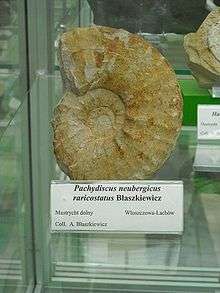Pachydiscus
Pachydiscus is an extinct genus of ammonite from the Late Cretaceous with a worldwide distribution, and type for the desmoceratacean family Pachydiscidae. The genus' type species is P. neubergicus. Altogether some 28 species have been described.
| Pachydiscus | |
|---|---|
 | |
| Scientific classification | |
| Kingdom: | |
| Phylum: | |
| Class: | |
| Subclass: | |
| Order: | |
| Superfamily: | |
| Family: | |
| Genus: | Pachydiscus Zittel, 1884 |
| Synonyms | |
|
Parapachydiscus | |
The shell of Pachydiscus is compressed and high-whorled, with an oval or flat sided section. Ribs tend to be differentiated into short umbilical and separate ventro-lateral sets, with a smooth area between.
Pachydiscus includes two subgenera, P.(Pachysiscus) from the Campanian in which the ribs persist, and P (Neodesmoceras) from the Maastrichtian in which ribs disappear early, leaving an almost smooth shell.
Biostratigraphic significance
The International Commission on Stratigraphy (ICS) has assigned the First Appearance Datum of Pachydiscus neubergicus as the defining biological marker for the start of the Maastrichtian Stage of the Cretaceous, 72.1 ± 0.2 million years ago.
Distribution
Fossils of Pachydiscus have been found in Antarctica, Australia, Austria, Belgium, Brazil, Canada (British Columbia), Chile, Denmark, France, Germany, Haiti, India, Iran, Japan, Mexico, the Netherlands, New Zealand, Nigeria, Oman, Romania, the Russian Federation, Saudi Arabia, South Africa, Spain, Turkey, Ukraine, the United Arab Emirates, and the United States (Alaska, Arkansas, California, Delaware, Mississippi, New Jersey, Oregon, Texas, Washington).[1]
References
- Pachydiscus at Fossilworks.org
Further reading
- Treatise on Invertebrate Paleontology, Part L, Ammonoidea. R.C. Moore, ed. Geological Soc. of America and Univ. Kansas press. p L377-L380.
- A Pictorial Guide to Fossils by Gerard Ramon Case
- Cephalopods Present and Past: New Insights and Fresh Perspectives by Neil H. Landman, Richard Arnold Davis, and Royal H. Mapes
- Kennedy, W. J. (1986). Campanian and Maastrichtian Ammonites from Northern Aquitaine, France (No. 36). Palaeontological association. page 30